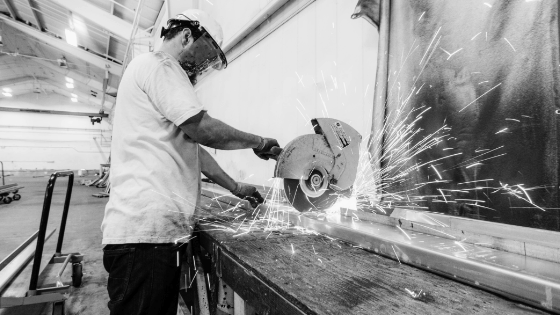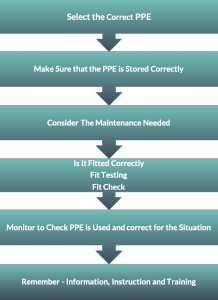Controlling Exposure Using PPE (Personal Protective Equipment): The Last Resort
The HSE’s fifth COSHH Principle relates to controlling exposure using PPE, “when adequate controls of exposure cannot be achieved by other means”. If you have followed the HSE guidance to this point, and been unsuccessful in effectively controlling exposure to hazardous substances, you will need to use PPE in combination with the controls you have already implemented. It should be stressed that PPE should only be used as a last resort; unless you are able to remove the hazardous substance altogether. The next best option is to minimise exposure at the point of release into the environment. In other words, you need to fully explore every other possibility, and minimise exposure as much as possible, before deciding to use PPE. It is always best to engage the services of a professional to ensure you are following regulatory requirements.
An Effective Control System
Effective workplace control systems usually involve a combination of different factors. For example, you may use Local Exhaust Ventilation (LEV), Respiratory Protective Equipment (RPE) and PPE in combination with working practices and processes. Whereas one of these control measures alone would be insufficient, an effective system is achieved when they are used together. But why should PPE only be used as a last resort?
Why is PPE a Last Resort?
Controlling exposure using PPE is complicated, because there are many different variable factors involved in its implementation. It is therefore generally less effective and reliable as a control measure. Where absolutely necessary, it should only ever be used on its own as a short-term measure. So, what are the problems with PPE?
- It has to be selected for the individual – depending on their individual job role and areas of responsibility.
- PPE has to be the correct size and shape to fit the individual wearing it.
- In order to be effective, it has to be put on (and used) correctly every single time.
- It must continue to be properly fitted throughout the duration of exposure.
- PPE has to be stored correctly and regularly checked and maintained.
- It is often relatively delicate, and so easily damaged.
- PPE sometimes fails without warning.
A High Opportunity for Failure
Given the fact that there are at least seven ways in which PPE can fail, the opportunity for something to go wrong is high. Therefore, it is not an adequate control method. Furthermore, PPE only protects the individual wearing it. Controlling Exposure using PPE is therefore an expensive option – especially when there is the potential for it to be incorrectly used by employees. In contrast, process controls are more reliable and cost less in the long term too.
Minimising the Risk of Using PPE Where Necessary
However, where the use of PPE is necessary in combination with other control measures, it is vital to ensure it is adequate and suitable to its intended purpose. In the context of PPE, ‘adequate’ means that it can provide the protection level required; ‘suitable’ means it fits the needs of the individual wearing it and the area of work and the task in hand.
All those using and supervising the use of PPE need to be trained in correct usage; from storage and maintenance to checking its effectiveness. Getting people to actually use PPE can also be a challenge. However, if you are able to provide your staff with a choice of PPE suitable for the situation in hand (and individual concerned) it is more likely to be used.
We’re here to help
At Workplace Exposure, our expert team have experience working with a variety of different businesses to ensure they offer a safe, compliant working environment. Our professional solutions and advice help to ensure your business meets compliance standards and is operating to best practice. If you need help in carrying out a COSHH air monitoring survey to help select the correct PPE, or your workplace noise assessment, we’re here to help.
Our approach
Get in touch with Workplace Exposure. Either give us a call on 0800 689 4386, or fill in our enquiry form to discuss your monitoring or consultancy requirements.
We’ll then provide you with a no obligation proposal, we can often give an initial idea of fees whilst we discuss your needs.
Once you’ve accepted our proposal we can then schedule the work.
Following our site visit we’ll provide you with a comprehensive report giving you advice, recommendations and control measures where appropriate. Implement the outcomes for compliance and a happier healthier workplace.

